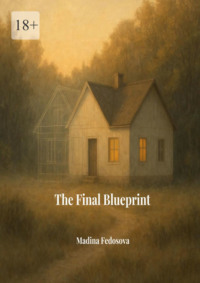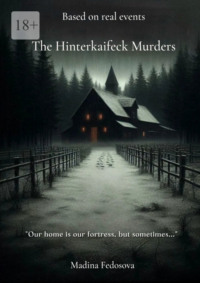
Полная версия
The lost self

The lost self
Madina Fedosova
© Madina Fedosova, 2025
ISBN 978-5-0065-6537-1
Created with Ridero smart publishing system
Annotation:
In the wake of an unspeakable loss, Eleanor Vance seeks solace at Serenity Labs – a sanctuary promising to erase pain and restore inner peace through its groundbreaking “Empathon” therapy. But behind the tranquil façade lurks a chilling truth: “Empathon” doesn’t simply heal trauma; it reprograms the mind.
As Eleanor tentatively rebuilds her life, subtle fissures begin to fracture the seemingly perfect calm. Memories erode, emotions become muted, and fellow patients undergo increasingly disturbing transformations.
Haunted by fractured glimpses of her past and driven by an enigmatic message from beyond the veil, Eleanor embarks on a desperate quest to expose the sinister secrets of Serenity Labs before her very self unravels.
Introduction:
Grief is a labyrinth, a winding maze of sorrow and despair capable of consuming the very soul. We search for an exit, a path to transcend the darkness and return to the light. But what if the road to healing leads into an even deeper darkness, a place where our very essence is at stake?
This is the story of Eleanor Vance, a woman shattered by loss who dared to believe in the promise of serenity. It is a journey into the heart of Serenity Labs, a place where the lines between therapy and manipulation blur, and the pursuit of peace demands a terrifying price.
Prepare to question everything you think you know about memory, identity, and the true meaning of control. Immerse yourself in a world where the mind is a battleground, and the greatest battles are fought not with weapons, but with whispers. Welcome to The Lost Self.
Chapter 1: Winter in Vermont
Six months have passed
Eleanor lived in Vermont, a town clinging to the rocky coast like a barnacle to a weathered ship. It was a place of stark contrasts, where the untamed power of the ocean clashed with the genteel charm of Victorian architecture, where salt-laced air carried the scent of blooming magnolias and decaying seaweed.
The town was a patchwork of neighborhoods, each with its own distinct character. There were touristy waterfront districts bustling with seafood restaurants and souvenir shops. There were historic areas with stately mansions and hushed streets. There were working-class neighborhoods where fishermen and dockworkers eked out a living, their lives governed by the tides.
Eleanor’s house was located in one of the quieter residential areas, a two-story Victorian with a wraparound porch and a sprawling garden. The house had belonged to her family for generations, a silent witness to births, deaths, and countless ordinary moments.
Outside, the house was painted a soft gray, faded by years of salt-laden winds and bright sunlight. Hanging baskets overflowing with vibrant flowers adorned the porch, their sweet fragrance mingling with the salty air. The garden was a riot of colors and textures, a sanctuary where Eleanor found solace and inspiration.
Inside, the house was filled with warmth and comfort. Sunlight streamed through the tall, arched windows, illuminating the hardwood floors and antique furniture. The walls were adorned with paintings, landscapes, and portraits, each telling a story of Eleanor’s love and life.
Her kitchen always smelled of something baking. Whether it was her husband David or herself at the helm, they found joy in preparing meals for their family. The dining room was often filled with guests and laughter, a vibrancy now impossible to recreate.
Every room held a memory, a fragment of the life she had shared with David. In the living room, they had spent countless evenings curled up by the fireplace, reading books or watching movies. In the bedroom, they had whispered secrets and shared dreams. In the garden, they had planted flowers and watched them grow.
Eleanor Vance shivered and drew her wool shawl tighter around herself. The wind, a merciless icy blade, swept down from the Green Mountains of Vermont, whistling around her isolated cabin like a grieving spirit. Winter had descended upon the state with redoubled force, painting the landscape in shades of white and gray, mirroring the desolation in her heart.
Six months had passed since David was gone. Six months since her life had shattered, leaving her adrift in a sea of grief and unanswered questions. Six months since her husband, David Vance, a brilliant astrophysicist with a passionate love for the cosmos, had vanished without a trace.
Before the kayaking accident, before the emptiness that now haunted Vermont, there was David. David Vance, astrophysicist, dreamer, and the unwavering center of Eleanor’s universe. He radiated enthusiasm for the cosmos, a childlike wonder he effortlessly shared with everyone he met. From a young age, he had been captivated by the stars, spending hours gazing at the night sky, charting constellations, and dreaming of distant worlds. He earned advanced degrees and became a world-renowned expert. David dedicated fifteen years to the Vermont Observatory, dedicating his life to unraveling the mysteries of the universe. His office, always overflowing with scientific papers and astronomical charts, was a reflection of his brilliant, chaotic mind. But Eleanor loved him not just for his intellect, but for his heart. He laughed with a booming resonance that filled any room. He saw beauty in everything and made everyone feel valued. David was more than just a husband; he was her best friend, her confidant, her soulmate. His absence left a void in her life that seemed impossible to fill, a black hole threatening to consume her whole.
The official story, whispered in hushed tones by the people of Vermont, was that David had perished in a tragic kayaking accident on Lake Champlain.
He had always been drawn to the serene beauty of the lake, especially at dawn when the first rays of sunlight kissed the surface, painting it in hues of gold and rose. It had become a ritual for him, a meditative retreat before plunging into the complex questions of astrophysics.
One clear morning, when the sky promised a cloudless day, he set out in his kayak, eager to witness the sunrise over the Adirondack Mountains. That day, the lake was deceptively calm, concealing the threat of a sudden storm. Locals knew that Lake Champlain could be a fickle mistress.
An unexpected local squall, known to appear and vanish in a matter of minutes, swept across the lake. The sudden, fierce wind combined with torrential rain would have transformed the tranquil surface into a churning chaos.
Weeks later, his kayak was found overturned and drifting aimlessly on the waves. Authorities launched a massive search, scouring the shoreline and probing the depths of the lake. Helicopters circled overhead, scanning for any sign of David, but their efforts proved futile. All that remained was an overturned kayak, a grim testament to the lake’s capricious nature, and a growing unease in Eleanor’s heart that the story she had been told didn’t quite add up.
Eleanor couldn’t shake the image forming in her mind. David was an experienced kayaker, a meticulous planner. He wouldn’t have set out if the weather had been even remotely treacherous. Moreover, there were whispers, inconsistencies in the official account, small details that didn’t quite fit, all fueling her own disquiet.
She gazed around the cabin, a testament to their shared love for nature’s untamed beauty, built by their own hands, board by board. It was more than just a structure; it was a tangible embodiment of their dreams, a sanctuary fashioned from warm wood and rough-hewn stone. The cabin was unlike anything anyone had ever seen. The large stone fireplace, constructed from stones gathered in the surrounding forest, still carried a faint scent of pine and woodsmoke – a reminder of the countless evenings they had spent huddled together by its warmth, sharing stories and dreams beneath the watchful gaze of the stars. Wide, panoramic windows offered a breathtaking view of the surrounding wilderness – towering pines, moss-covered crags, and the shimmering surface of a secluded lake.
They had spent hours admiring the view, David pointing out constellations and sharing his knowledge of the local wildlife, while Eleanor sketched the landscapes, capturing their ever-changing moods on canvas. The cabin was their refuge from the world. He always said, “Eleanor, if we could, I’d live here with you and no one else.”
Now, the memories that once brought her joy felt like shards of glass piercing her heart. The cabin, once a sanctuary, had become a prison, each log and stone a constant reminder of his absence, a monument to a love tragically cut short. The silence within the cabin was deafening, broken only by the whisper of the wind in the trees, a mournful symphony that echoed the emptiness in her soul.
Before the accident, before the darkness descended, before the world leached of its color, Eleanor Vance was a dynamic architect, a rising star in her field, whom her peers knew for her intellect and artistry.
She had a passion for designing sustainable homes that seemed to grow organically from the earth, structures that blended into their surroundings rather than dominating them. She specialized in eco-friendly design, her work renowned for its innovative use of natural light, its harmonious integration of buildings with the surrounding landscape, and its unwavering commitment to creating spaces that nurtured the soul. Her designs were more than just structures; they were works of art. Every blueprint was meticulously crafted. She possessed an innate talent that seemed to foretell her future success. Her portfolio boasted a wide array of projects, from cozy woodland retreats to expansive coastal estates, each reflecting her unique vision and unwavering dedication to sustainable principles. She had been featured in architecture magazines, praised for her creativity and commitment to environmental stewardship. Eleanor was known for her collaborative spirit, her ability to inspire and empower her team. She treated every employee with respect and kindness, fostering a supportive and inspiring work environment. She had garnered numerous awards.
Her dark, almost raven-black hair was usually pulled back into a practical bun at the nape of her neck – a style that emphasized her pragmatic nature and unwavering focus. Stray strands often escaped the confines of the bun, framing her face with a rebellious energy, hinting at the creative fire that burned within. Her eyes, the color of a summer lake reflecting a clear sky, held a depth of understanding that seemed to penetrate beneath the surface. They could sparkle with insight when she discussed her designs or soften with empathy as she listened to a friend in need.
While Eleanor paid little attention to trends or flamboyant attire, she possessed an understated elegance and a natural grace that drew people to her. Her movements were fluid and confident, her posture erect yet relaxed, conveying a sense of inner strength and self-possession. She had a gift for putting people at ease, her genuine warmth and calm demeanor creating an atmosphere of trust and understanding. It was a subtle magnetism, an effortless charm that emanated from within, drawing people to her like moths to a flame.
Now, she was a mere shadow of her former self, a ghost haunting the remnants of her once vibrant life. The spark that had once ignited her passion for architecture had been extinguished, leaving behind an echoing void. She had abandoned her design work, which had once provided her with purpose and meaning. Her downtown office, once a bustling hub of creativity, now stood empty, a silent testament to her broken spirit. She neglected her appearance, her once-stylish clothes replaced by shapeless, somber attire, and her carefully applied makeup forgotten. Her usually bright eyes, once a reflection of a brilliant mind and a compassionate heart, were now clouded by a perpetual veil of grief, haunted by nightmares in which she relived the horrific events of David’s death. She often awoke screaming his name, as if he might hear her.
Her naturally slender frame had become even thinner, bordering on emaciated, and her once-healthy complexion had been replaced by a pallid hue. The weight of her grief had visibly aged her, etching deep lines around her eyes and mouth, transforming her into a frail, almost ethereal figure. It was as if life itself had been drained from her, leaving behind only an empty shell, a heartbreaking reminder of the radiant woman she had once been.
She spent most of her time lost in a haze of grief, wandering through the cabin like a phantom, replaying memories of David: his infectious laughter, his unwavering optimism, the way he absently hummed classical melodies while working on his complex equations. She touched his belongings, seeking solace in familiar textures and scents, clinging to fragments of their shared life.
Evenings were the cruellest hours of the day. The silence within the cabin, which had once been a comforting embrace, now pressed down on her, suffocating her with its vast emptiness. It was a silence so profound that she could hear the blood rushing in her ears – a constant reminder of the life that had been stolen from her.
She tried to distract herself by immersing herself in the pages of a book, hoping to lose herself in a world of words, but the letters blurred before her eyes, forming meaningless patterns. She tried watching movies, seeking a fleeting distraction in the flickering images on the screen, but the stories dissolved into background noise, unable to penetrate the wall of grief that surrounded her.
Nothing could alleviate the aching pain in her chest, the constant physical manifestation of her broken heart. Sleep offered no solace, no respite from the torment, only an endless stream of nightmares that replayed the horrific events of David’s death with agonizing clarity.
She would see the churning waves of Lake Champlain, hear the deafening roar of the squall, feel the icy touch of the water against her skin. She would watch the kayak capsize and David disappear beneath the surface, struggling. And then, a faceless figure, shrouded in mist, would appear, calling her name with a chilling whisper, luring her into the abyss. She would awaken in a cold sweat, her heart pounding, the line between dream and reality blurred, trembling with terror in the darkness.
Her best friend, Sarah, a vibrant artist with a shock of fiery red hair and a laugh that could light up a room, often visited the cabin, offering her unwavering friendship and heartfelt support. Sarah was everything Eleanor was not at the moment: full of energy, radiating positivity, and determined to pull her friend from the abyss. Sarah earned a living as an artist and knew what it meant to fight for your dreams. “You can’t live like this, El,” she would say, her voice filled with concern, her bright green eyes reflecting Eleanor’s pain. “You need to get out of here, do something, reconnect with the world. David wouldn’t want you to wither away like this. He would want you to be happy.”
Sarah brought art supplies, hoping to rekindle Eleanor’s creative fire, encouraging her to paint the landscapes that had once inspired her. She suggested walks in the woods, pointing out the beauty of the wildflowers and the majesty of the ancient trees, reminding Eleanor of the joy she had once found in nature. She invited her to local art galleries, hoping to stimulate her mind and introduce her to other artists. She even offered to redecorate the cabin, injecting some much-needed color and light. They were very close and knew everything good and bad about each other.
“I can’t, Sarah,” Eleanor would reply in a barely audible whisper, staring blankly ahead, lost in the labyrinth of her grief. “I just can’t. There’s no point. David is gone. And a part of me went with him. There’s nothing left for me here.” Sarah’s heart ached as she watched her friend so broken, so completely consumed by grief, but she refused to give up. She knew that Eleanor was still in there, buried beneath layers of sorrow and despair, and she was determined to find a way to bring her back to the world of the living.She knew that sooner or later, she would break through, if she just had enough time.
New Beginnings?
On one particularly bleak day, as the rain hammered against the windows of the cabin, mirroring the storm raging within Eleanor’s soul, Sarah arrived with a stack of magazines and a glossy brochure. This time, it wasn’t art supplies or hiking gear. This was something different, something Sarah hoped would offer a glimmer of hope. The materials were about the “Phoenix Institute,” a research center nestled amidst the serene landscapes of upstate New York, specializing in innovative treatments for grief, trauma, and post-traumatic stress disorder. Sarah said she had found it while searching for information on trauma and bereavement and took it as a sign. “I knew you could get better,” she whispered. “I’m so sorry.”
Sarah explained that she had chosen the Phoenix Institute because it appeared to offer a more holistic approach to healing than traditional therapy, combining cutting-edge advancements in neuroscience with compassionate care. She pointed to articles highlighting the institute’s use of innovative techniques such as “memory reconsolidation therapy” and “emotional regulation training,” which purportedly helped patients process traumatic memories and regain control over their emotions.
The brochure contained testimonials from former patients, detailing how the Phoenix Institute had helped them find peace and purpose after unimaginable loss. One image, in particular, caught Sarah’s eye – a photograph of the pristine, modern buildings of the Institute nestled among rolling hills and verdant forests. It was a stark contrast to the claustrophobic walls of the cabin, a vision of hope and renewal in a world that seemed to have lost its color. Little did Sarah suspect that the serenity depicted in the photograph was merely an illusion. The storm would begin with this thought.
“They’re looking for participants in a research study about trauma and grief,” Sarah explained gently, her tone carefully measured so as not to overwhelm Eleanor. She reached out, offering the brochure to Eleanor, but without pressuring her to take it. This was her way of respecting boundaries. “They’re experimenting with a new type of therapy, something like… personalized treatment designed to help people manage their emotions, regulate their reactions, and ultimately find a way to move forward.” Sarah’s eyes searched Eleanor’s face, seeking any flicker of interest, any sign that her words were getting through. She had spent hours researching the Phoenix Institute, poring over their website and reading articles about their work, trying to determine whether it was a legitimate program or just another empty promise. She genuinely believed that it could help Eleanor, but she also knew that pushing her too hard could backfire.
“It’s not about forgetting David, El,” Sarah emphasized, her voice softening. “It’s about finding a way to live with the pain, to honor his memory without letting it consume you.”
“It’s a way to rediscover yourself without him,” she paused, then added, “They say it’s a completely new approach, using cutting-edge technology and personalized medicine to address the root causes of trauma. Sounds a little… out there, but the results seem promising. The brochure claims an eighty-nine percent success rate. Maybe this is what you need to shake things up in your life.”
Eleanor cast a fleeting glance at the brochure, her eyes skimming over the glossy images of smiling faces and the dense walls of scientific jargon. The sterile, clinical language felt impersonal, a cold attempt to quantify the messiness of human emotion. “I’m not interested,” she said in a flat, toneless voice. “I don’t need some drug to manage my feelings. And what even is ‘Empathon’?”
“Just think about it, El,” Sarah pleaded, a note of desperation creeping into her voice. “You deserve to be happy again. You deserve to reclaim your life. David wouldn’t want you to live like this, trapped by your grief. He would want you to be happy, designing new homes, tending your garden. Laughing!”
Eleanor sighed, and the sound was heavy with exhaustion. She reluctantly took the brochure from Sarah and turned it over in her hands, as if it were a foreign object, something dangerous and unfamiliar. The Phoenix Institute. It sounded like a cliché, a too-easy solution to a broken heart, an empty promise of resurrection. It was another word she had never heard before, and she hated it.
“Okay, Sarah,” she said with a hint of sarcasm in her voice. “I’ll think about it. Just to humor you. I promise. Now, can we please talk about something else? Anything else?” She closed her eyes and sighed.
Sarah squeezed Eleanor’s hand, and a wave of compassion washed over her face. “Of course, El. Anything you want.” She paused, then added softly, “I’m always here, no matter what. Remember that.”
But after Sarah left, as the silence of the cabin settled around her once more, Eleanor found herself staring at the brochure. The glossy images suddenly seemed less artificial, the scientific jargon less daunting. A flicker of curiosity ignited within her, a tiny spark of hope trembling in the darkness. Could this be a way out of the gloom? Could this “Empathon,” as they called it, this miracle cure, truly help her heal? Could it erase the pain, silence the nightmares, and restore even a sliver of the joy she had once known? She closed her eyes, then reached for a photograph of her and David. His smile was everything. She missed him terribly.
Chapter 2: The Call of the Phoenix
2.1 Down the Rabbit Hole
Weeks bled into months, and Eleanor found that she couldn’t dismiss Sarah’s suggestion as easily as she had initially intended. The Phoenix Institute brochure remained on the coffee table, a constant, nagging presence. She couldn’t ignore it. At first, she tried to avoid it, burying it beneath stacks of books and magazines, but the brochure always resurfaced, as if drawn to her like a magnet. The glossy images and scientific jargon, once intimidating, began to feel like a lifeline in the vast ocean of her grief. With each passing day, the cabin felt more like a prison, and she felt herself becoming increasingly isolated. Lying in bed, staring at the ceiling, she began to weigh the pros and cons of going to the Phoenix Institute.
She found herself absentmindedly flipping through the pages, rereading the testimonials, studying the photographs of the serene facilities. She discovered herself researching the Institute online, poring over articles about their studies and reading reviews from former patients (though she approached them with skepticism). Despite her initial resistance, a spark of hope had taken root within her. Could this truly be a way out? Could the Phoenix Institute offer her a chance to shed the crushing weight of her grief, to reclaim her life from the clutches of despair? The more she pondered it, the more she wondered if this was indeed the first step she needed to take to rescue herself from this darkness.
The brochure became a symbol of her internal struggle, a tangible embodiment of the battle between her rational mind and her desperate heart. It was a reminder of the possibility of healing, but also a warning of potential disappointment. But if there was a chance to feel happy again, she had to take it.
The thought of not living with the pain that she felt every day consumed her, pushing her to look at the brochure. She could no longer live in the shadow of despair. She knew that she needed something radical to break free from this state. If she didn’t get better, she feared she might take her own life.
She immersed herself in a meticulous online investigation of the Phoenix Institute, spending hours exploring their website, reading articles about their work, and scrutinizing every detail. Her attention quickly focused on the charismatic founder of the institute, Dr. Alistair Thorne, a renowned neurobiologist who had garnered international recognition for his groundbreaking research in the field of emotional regulation.











